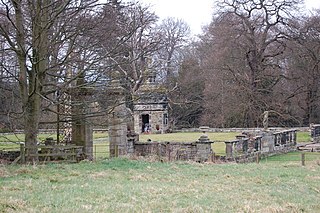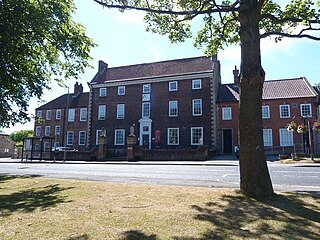
John George Lambton, 1st Earl of Durham,, also known as "Radical Jack" and commonly referred to in Canadian history texts simply as Lord Durham, was a British Whig statesman, colonial administrator, Governor General and high commissioner of British North America. A leading reformer, Durham played a major role in the passage of the Reform Bill of 1832. He later served as ambassador to Russia. He was a founding member and chairman of the New Zealand Company that played a key role in the colonisation of New Zealand. George Woodcock says that he was, "Proud, wayward, immensely rich, with romantic good looks and an explosive temper." He was one of those "natural rebels who turn their rebellious energies to constructive purposes. Both at home and abroad he became a powerful exponent of the early nineteenth-century liberal spirit."

Lambton Castle stands above Chester-le-Street, County Durham and is a stately home, the ancestral seat of the Lambton family, the Earls of Durham. It is listed in the mid-category of listed building, Grade II*.

Ickleton is a village and civil parish about 9 miles (14 km) south of Cambridge in Cambridgeshire, England. The village is beside the River Cam, close to where a southern branch of the Icknield Way crossed the river. The eastern and southern boundaries of the parish form part of the county boundary with Essex, and the Essex town of Saffron Walden is only about 4.5 miles (7 km) southeast of the village.

Hylton Castle is a stone castle in the North Hylton area of Sunderland, Tyne and Wear, England. Originally built from wood by the Hilton family shortly after the Norman Conquest in 1066, it was later rebuilt in stone in the late 14th to early 15th century. The castle underwent major changes to its interior and exterior in the 18th century and it remained the principal seat of the Hylton family until the death of the last Baron in 1746. It was then Gothicised but neglected until 1812, when it was revitalised by a new owner. Standing empty again until the 1840s, it was briefly used as a school until it was purchased again in 1862. The site passed to a local coal company in the early 20th century and was taken over by the state in 1950.
The Bulmer family were a noble family of Norman England, resident in Yorkshire. The family takes their name from Bulmer, North Yorkshire. The name Bulmer comes from English "Bull mere", a lake frequented by a bull, and is an Anglicised form of Gaelic "Búir na mara" from the Celtic tribe Brigantes during their occupation of the area. Ansketil de Bulmer was the first documented member of the Bulmer family who lived in the area in the twelfth century with the current spelling.
The Selby family is an American business and political family in the English gentry that originated in Selby, Yorkshire, but largely settled in Northumberland and County Durham. At various points through history, the family owned Biddlestone Hall and Twizell Castle in Northumberland in addition to the manor houses Ightham Mote in Kent and at Beal, Northumberland. The family had two baronetcies; the Selby and the Selby-Bigge but both are now extinct.
The Ogle family were prominent landed gentry in Northumberland, England. The earliest appearances of the family name were written Hoggel, Oggehill, Ogille and Oghill.

Welcombe Hotel occupies a 19th-century former country mansion house near Stratford upon Avon, Warwickshire, which was previously known as Welcombe House. It is a Grade II* listed building.
Dinsdale Park is a 19th-century mansion and former Spa hotel at Low Dinsdale, near Darlington, County Durham, England now converted into residential apartments. It is a Grade II listed building.

Hamsterley Hall is an 18th-century English country house at Hamsterley, Rowlands Gill, County Durham, England. It is a Grade II* listed building.

The Grove is a large hotel in Hertfordshire, England, with a 300–acre (1.2 km2) private park next to the River Gade and the Grand Union Canal. It touches on its north-west corner the M25 motorway and remains a small part in Watford. The estate is situated within three different settlements; most of the land and all of the mansion itself are in the civil parish of Sarratt, and also in the ecclesiastical parish of Langleybury, while the estate lies within the post town of Rickmansworth.
John Tempest Jr. was a County Durham landowner and Tory politician who sat in the House of Commons from 1768 to 1794.

The Tempest family was an English recusant family that originated in western Yorkshire in the 12th century.
Aubone Alfred Surtees was an English rugby union forward who played international rugby for the British Isles XV that toured South Africa in 1891.

Cottisford is a village and civil parish in Oxfordshire, about 3.5 miles (5.6 km) south of Brackley in neighbouring Northamptonshire. The parish's northern and northwestern boundaries form part of the boundary between the two counties. The parish includes the hamlet of Juniper Hill about 1 mile (1.6 km) northwest of Cottisford. The 2011 Census recorded the parish's population as 216.

Biddick Hall is a small privately owned 18th-century country mansion at Bournmoor, County Durham, near the City of Sunderland and Chester-le-Street. It is a Grade I listed building and the home of the Lambton family.

Grafton Manor was established before the Norman Conquest. Grafton means "settlement at or near the wood" and may indicate a role in woodland management within a larger estate, for instance.

Appleby Hall was a manor house or stately home built in the small hamlet of Appleby Parva, on the outskirts of Appleby Magna.

Hardwick Hall in Sedgefield, County Durham is a building of historical significance and is a Grade II listed building on the English Heritage Register. A major part of it was built in the late 1700s but it is possible that some of it dates from about 1634. It was the residence for many notable people for two centuries. It is now a hotel which provides accommodation and restaurant services and caters for special events particularly weddings.

The Manor House in Sedgefield, County Durham was built in 1707 on high ground in a country setting looking on to St. Edmund's Church as a mansion house for wealthy judge Robert Wright. Its notoriety arises from the eminence of the judge of Middle Temple who went on to be Chief Justice of colonial South Carolina and also because it is a rare example of Queen Anne style architecture in an area as far north as Sedgefield, with fine and distinctive architectural features including, reportedly, a wood carving by Grinling Gibbons. In 1756 the house was acquired by John Burdon of nearby Hardwick Estate who installed a noteworthy Palladian Venetian window very likely by the architect James Paine. In the twentieth century the Manor House was the head offices of Sedgefield Rural District Council and after that Sedgefield Magistrates' Court.














